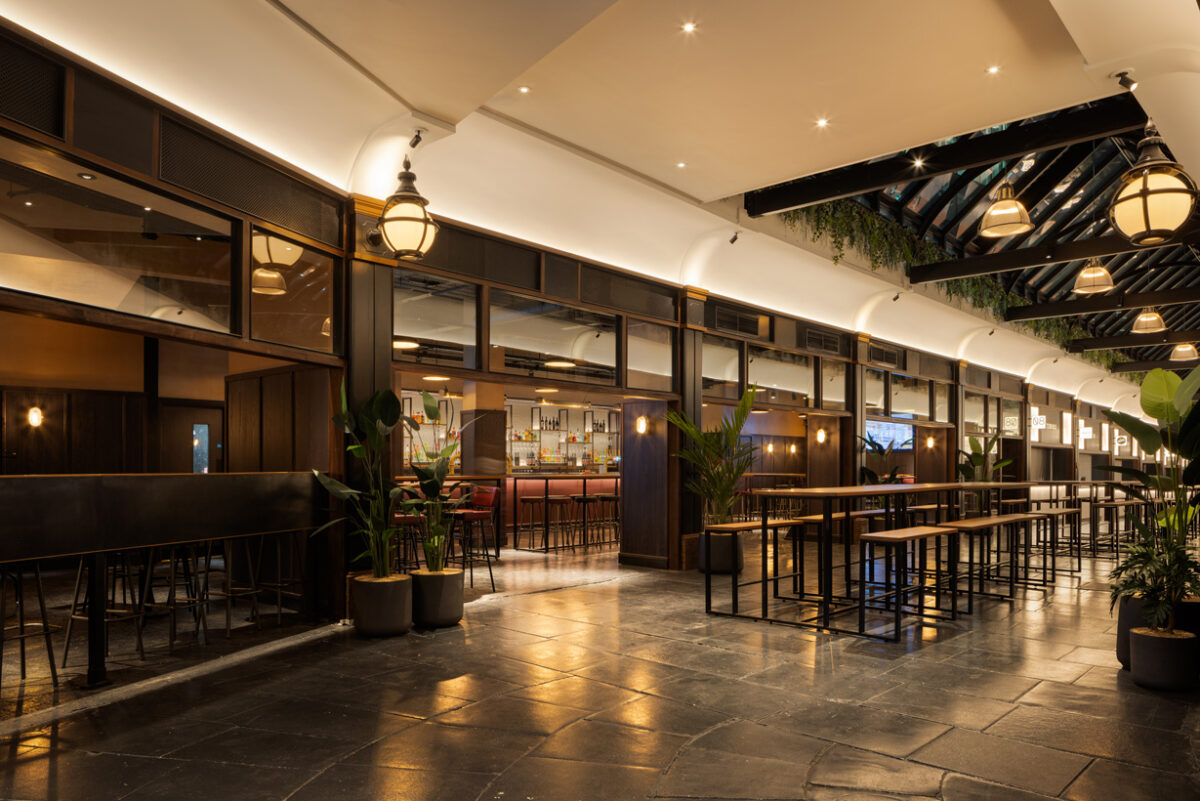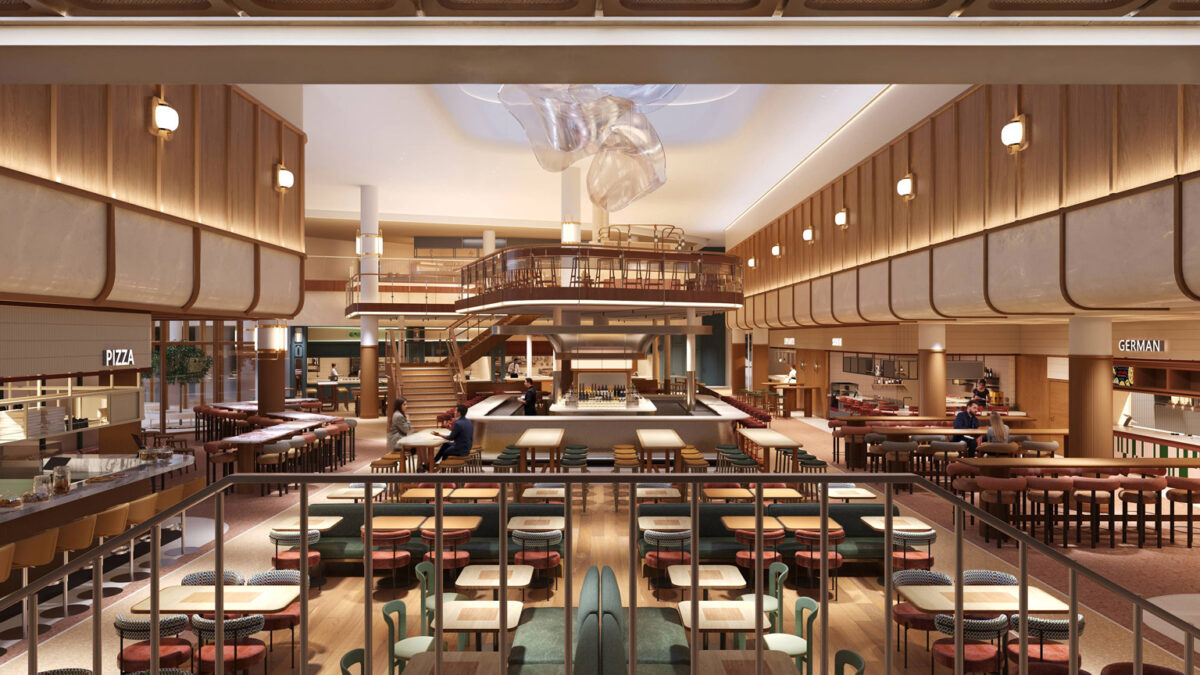More than just a place to grab a bite, food halls have exploded in popularity, evolving into social hubs and lifestyle destinations. These vibrant, dynamic spaces are often brimming with multiple food vendors and offer a diverse array of culinary experiences under one roof.
The appeal lies in the ability for individuals or groups to explore various cuisines, often encouraging the sharing of dishes and fostering a communal dining experience. Even pioneering concepts like Arcade Food Hall in London, a design-forward food hall that burst onto the scene roughly three years ago, underscore their vibrant and multifaceted nature.
The surging popularity of food halls can be attributed to factors such as the attractive price point, fast service, diverse food options and the flexibility of dining alone or in both small and large groups. Whether you’re looking for a solitary lunch or a gathering spot for friends, the informal and open layout accommodates various social dynamics.
Furthermore, food halls are undeniably stylish and have become desirable places to be seen, with their often-abundant natural light, striking colours and bold use of materiality.
The difference between food halls and food courts
While both offer multiple food options, there are key distinctions between food halls and traditional food courts. Food courts typically feature more established brands and often exist within retail environments, catering to a more transient customer base.
Food halls, on the other hand, are conceived as more of a destination in themselves, offering a curated and often more independent selection of vendors. Interestingly, even established retail giants like Ikea are exploring the food hall concept, signalling an exciting evolution in this space.
The different types of food halls
The landscape of food halls is widespread and varied, meaning there are different ideas about what constitutes a food hall. However, from our experience we can identify three main stylistic approaches; formulaic, eclectic (more traditional) and then design-led. While each style has some crossover, their approach differs in terms of concept.
In addition, there are food halls that aim to lean on offering a particular service, rather than style approaches. These include; convenience, community-focused, and incubator, each providing a different purpose to both customers and vendors.
Formulaic food hall design: adhering to brand
Exemplified by Time Out Market halls across Europe, these spaces often adhere to a similar aesthetic, prioritising a consistent brand experience.
Our work with BOXPARK, with its collection of repurposed shipping containers, also follows a relatively uniform vibe. These tend to be monochromatic in aesthetic, emphasising huge standardisation where each food vendor looks the same as everyone else. Kitchens often follow a linear format, congregating around a large open-plan customer experience with communal benches and rows of seating like a cafeteria.
While efficient, this model limits opportunities for vendors to display their unique brand identity beyond a designated space and signage zone.

Eclectic food hall: celebrating tradition
In contrast, the approach of spaces like New York’s Chelsea Market and Mercato Metropolitano in London feel more like traditional markets, embracing a vibrant and seemingly unstructured aesthetic where vendors outplay each other visually. The colour scheme is vibrant, materiality is bold, and the lack of rigid structure can give a chaotic yet hugely appealing feel, evoking the sense of a melting pot of cultures and cuisines. While the overall space is planned in terms of layout, the individual vendor set–ups tend to evolve more organically.
Design-led: a showcase of style
Then there’s the distinctive look of market halls such as London’s Arcade Food Halls, and Frankfurt’s Distrikt Marquet. These design-led, lifestyle interior food halls prioritise aesthetics. They feature more deliberate design, with a curated palette of materials that may even be offered to the vendors to ensure a cohesive yet individual look.
The aim is to understand each brand’s identity so that the design complements it while maintaining an overarching aesthetic vision. For instance, Arcade Food Hall’s mid-century inspiration is evident in its use of terrazzo, marmoleum, tiling, mosaics, and stainless steel – materials commonly found in mid-century interiors. Generally, design-led food halls feel more contemporary than the traditional models.
Design-led spaces often offer a more elevated dining experience and necessitate flexibility beyond just good food. This can include live performances, regular DJ programmes, events, adaptable furniture, and the capacity to host corporate events. High-profile brands might even want to take over spaces for product launches. Digital art and installations, such as sculptures and light fittings, can also feature, creating a memorable and unique experience that encourages photo opportunities and allows guests to truly sit within the environment.

Convenience food halls: catering to changing needs
Flexibility in food halls is paramount to success, so underpinning all these styles is the appeal of international cuisine, catering to the everyday food and beverage needs of diverse people at different times of the day. Food halls must also be designed to handle significant peak-time capacity – often 200-300 more people can arrive in a short lunch or dinner period. This highlights the huge significance of operational and customer flow and ergonomics in the design process to ensure a fluid and safe environment, ultimately leading to the best ROI for clients.
We’re also seeing the introduction of retail, even printer hubs, in food halls, further enhancing convenience. The rise of mixed-use developments, with offices and residential spaces located nearby, further fuels this demand. Frankfurt’s Distrikt Marquet, for example, sits at the base of a glass skyscraper, catering to a large population of office workers who need everything at their fingertips.
Community-focused food halls: bringing people together
Community-focused food halls are spaces that modern society has become accustomed to. A food hall can function like a town square, offering opportunities for individuals and groups to stop or pause – not just a thoroughfare – but also a place for socialising and meeting. Unlike traditional restaurants, where dining alone might feel less comfortable, the open nature of food halls is more inviting. This accessibility is what makes food halls uniquely unifying.
Incubator food halls: supporting new business
The mix of vendors in food halls often sees these spaces function as testbeds or an incubator for their menus. We’re seeing vendors and brands with existing street food offers using smaller showcase kitchens to trial new dishes or introduce new chefs. This aligns with the lifestyle trend of social media and Instagrammable dishes, proving to be a valuable way of extending brand reach.
Tips for food hall design success
Designing a successful food hall involves a multitude of considerations. Operations are paramount; the layout must facilitate efficient workflow for vendors and seamless navigation for customers. Lighting is also crucial, needing to adapt to different times of day to create the right ambiance.
Contemporary design in food halls is often expressed through colour, playful forms, and materiality. There’s often a careful balance with nostalgia, incorporating reclaimed items, flooring, light fittings, and interesting pieces to create a layered feel that blends modern and bygone eras.
Looking for food hall design companies?
At Macaulay Sinclair, our food hall design experience encompasses a variety of locations and concepts.
Some are steeped in heritage, like BOXHALL City and the Edwardian Metropolitan Arcade building. Others are more about working with large volume spaces, such as Distrikt Marquet, where we introduced a tongue-shaped mezzanine to both break up the environment while also creating an aspirational place to sit, bringing guests closer to the standout skylight.
Whether it’s working with various materiality and historic elements, or the blank canvas of a shipping container, the ambition is always to create a compelling customer journey that generates interest and brings people back time and time again.


